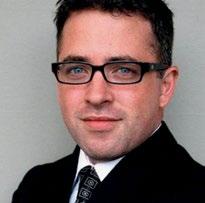
3 minute read
Our Friend in Scotland
SCOTLAND OUR FRIEND IN
Amid-March morning – 11 March, to be precise. Outside the boardroom window there’s rain and a howling wind. Lights flicker briefly as the meeting of STV News managers gets started. We’re not socially distanced – not yet.
Advertisement
News of the coronavirus has been rising in everyone’s consciousness, even though the outbreak still seems far away. The situation is serious in Italy, and the news from Spain is also grim. Scots consider unrestricted access to Spanish islands their vaca tion birthright. Things are closing in. We play out a few scenarios, exploring the boundaries of what would be possible as the pandemic takes hold and affects our ability to get the news out. Could the digital team work from home?
We can broadcast our programme from Glasgow, Edinburgh or Dundee. What if all three studios have to be closed for health reasons?
I walk back to my desk and send an impulsive note to our digital reporting team. I can sense eyes rolling across the newsroom as the message lands. But it feels good to be doing some thing – anything – to get in front of the wave of sickness and isolation that was on the way.
“Let’s not wait for an emergency work-from-home situation to have an emergency work-from-home situation,” I write. “Digital news staff are hereby banished to their homes until 19 March – and possibly longer.” The next morning brings another drastic change. “As part of our con tingency planning to limit the potential impact of coronavirus, we will close the Edinburgh office as of Mon day to ensure that it is clean and able to be used if the other two studios
Being inventive has become a way of life for STV’s news operation, explains Steven Ladurantaye can’t be,” I write. These early intrusions into the daily routines of our newsrooms set the tone for the unpredictable weeks to come. Within a week, we had decided to move to one programme across all of Scotland.
We usually broadcast separate shows for the north and the central belt, and provide bespoke content for our Glasgow, Edinburgh, Dundee and Aberdeen versions.
Our current affairs programme, Scotland Tonight, moves from four nights a week to a single primetime slot. We’re using it for questionand-answer pieces with health experts and top-level government decision makers.
These innovations are made in a tsunami of conflicting information and confusing guidance from the world’s experts. But they are all made with two underlying assumptions. High-quality public service news is more impor tant than ever. And we have a moral imperative to keep staff safe as they deliver potentially life-saving information.
There’s something incredible about the way newsrooms power through big stories with a sense of invincibil ity. There’s a deeply ingrained belief that anything is possible if you just keep pushing as hard as you can and ignore the bags under everyone’s eyes. Most stories have a clear begin ning and a clear end. This one certainly has a beginning, but no one can see an end as yet. STV News is running flat out to reflect the country back to itself. We want to make sure everyone has the vital information they need to keep their families safe through what is likely to be the most terrifying period they have experienced.
Our staff are living all the journal ism clichés. They’re tireless, worldweary, relentless, accurate, clever and dedicated.
Change are swift. Governmentimposed restrictions push even more staff into isolation. Video calling becomes the new normal. Reporters are deployed remotely, self-shooting and editing from their kitchen tables. Our studios are running with a skele ton staff. Being inventive has become a way of life.
Our average audience has doubled. But we also need to take care of each other and collaborate with our friends across the entire media sector to deliver the trustworthy news people need and demand during this crisis. Now more than ever, we really are all in this together. n Steven Ladurantaye is head of news and current affairs at STV. STV










